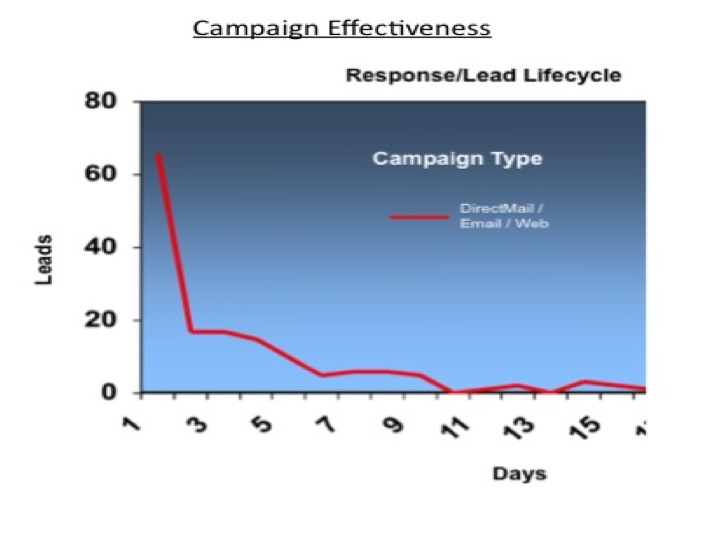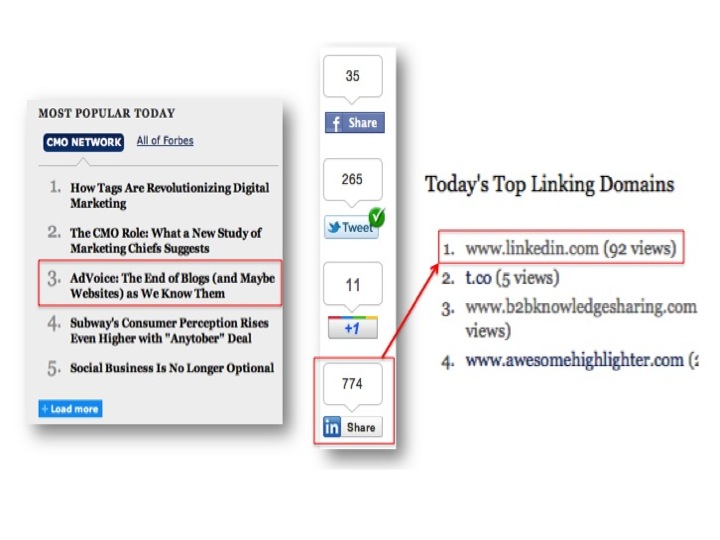by scott.gillum | Aug 20, 2012 | 2012, Marketing
Everybody knows – or thinks they know intuitively – that social elements add value to marketing. The question is how?
Like anything in business, it comes down to return on investment. Social media is not a strategy and it’s not an end in itself. Unless your business objective (and I’d check with your shareholders on this) is only about gaining page views and follows, marketers need to understand how social adds value to everything else in your toolkit.
So how do you find the “sweetspot” for developing an ROI for social media? Well, start by viewing the tools at their most basic level, as vehicles for sharing and; photo’s, thoughts, content, etc. Consider them “levers” for improving the performance of known activities that have produced a ROI.
Five years ago, we assessed the effectiveness of demand generation campaigns for a client. Because the firm was in the hi-tech industry they had a heavily reliance on content marketing for their campaigns. They spent months designing and building them, and hundreds of thousands of dollars in execution only to see diminishing results.
The audit revealed that their campaign effectiveness (related to lead production) lasted roughly 36 hours after launch (see below). Meaning that the majority of the leads were being created within the first three days of launch, regardless of how long they left the campaign in the market (btw – they are not alone).

Today, social media has the potential to create a long tail, extending the life of expensive campaigns, ultimately improving ROI, and along the way creating and deepening the relationship with the audience.
I’ll use myself as an example: A blog post of entitled The End of Blogs (and Websites) as We Know Them ran recently in on Forbes. It received no special promotion; in fact, you could say the deck was stacked against it. Posted on a Friday, the slowest traffic day of the workweek, at midnight (EST) when most of the blog readers at home or are in bed. By prime blog viewing time (10 am) it had almost dipped below the fold.
But on the following Monday it took off, almost doubling the views of Friday, and continued to build momentum ending the week as the 3rd most popular post of the day. The following week it was the most popular post on Wednesday. So what happened?
Social took over. Without any additional investment to promote the post, social sharing accelerated and extended the life of the post, even as it fell off the first, second and third page of the site. Readers engaged and went from passive viewers to active promoters.
Readers were tweeting their own thoughts and comments about their insights, not just retweeting the post title. They placed in into Linkedin groups adding their comments on the impact of the technology (the topic of the post) to their particular area of interest or role. They were actively engaging in sharing their “discover” with others.
 That is the power and the value of social media for content marketing.
That is the power and the value of social media for content marketing.
The post no longer needed to be pushed because it was being endorsed, and in some ways validated, by readers — the most trusted source of information.
The potential of social media is intriguing, but to determine its true value companies will need to experiment. Using social media to support your content marketing efforts is a prudent choice, but keep this in mind: It will only be effective if the audience/community finds value in the content and part of that value is defined by those who pass it along.
by scott.gillum | Jul 31, 2012 | 2011, Observations
Original post date February 17, 2011
On the flight to LA the other day I read an article about Evan Williams, founder of Twitter and Blogger.com. In the article, Williams was asked what the difference was between Twitter and Facebook. He said, “Twitter has information about what’s going on in the world that you care about and that’s different from Facebook’s value proposition, which is a way to stay in touch with people you know.” Coincidently, The Social Network was the in-flight movie.
As I thought about those comments, and the movie, it exposed an area of our lives that seems to be missing from social platforms. If Facebook connects us with our friends and family, and Twitter to “the world we care about,” what connects us in our daily lives? I’m talking about our local area, city and neighborhood, our offline community, the world in which we live everyday.
The more I thought about the need the more it seems like it’s not as much a social platform as it is a functional tool or in other words, an enabler; how can a platform make our lives easier by linking our social network with practical and time saving tools.
For example, my wife is a “room mother” at one of our child’s schools. Her role is to plan, organization and host class events…and chase other parents to contribute time, money, food or all of the above. She uses old Web 1.0 tools like email, a group mailing list, and the phone to accomplish her tasks.
In addition, our kids are active in sports, which requires carpooling, registrations, getting directions to games, status updates on field conditions all done via separate web sites or portals. On top of that our lives – thanks to mobile devices – now mix personal and business hours all throughout the day, and they often collide.
My hope for Web 3.0 is that it will evolve as specific applications of Web 2.0 tools that provide efficiency. These applications will be developed through the greater understanding of how we live our daily lives. The paradigm shift is moving from investing time online to maintain our presence (through FB, etc.) to having online tools that enable us to be more present in our offline world.
What might that platform look like? It’s mobile, and it could include any or all of the following:
- Reviews become Recommendations – components of Yelp, Tripadvisors, etc. for local restaurants and merchant, but also, reviews, recommendations and contact information for teachers, coaches, babysitters, etc.
- Groups become Communities – like a Linkedin or Facebook group organized around local groups/clubs you participate in, including church, school, athletic teams, etc. Communities are built automatically when you register to join.
- Discounts & Loyalty Programs become Active– a Groupon.com like application for local merchants, GPS and mobile enabled to pop offers in the store and automatically tracks your spend. Additionally it would allow us to pool and direct our points to local groups (see above).
- GPS locator becomes an Status Alert – a mash up of GPS and Foursquare, alerting us to movement and activity of family members (especially teenagers) at any moment.
- Lists with Automated Fulfillment – this is a big one, a digital list builder that sync’s with Peapod (or other Grocery Store home delivery service), with a shopping cart threshold that will automate trip deliveries and credit coupons.
- Reminders become Personal Assistants – voice activated and controlled, adds and reads calendars. Helping us remember school plays, play dates, birthdays and especially anniversaries.
In the movie, Zuckerburg asked Sean Parker (co-founder of Napster) his advice about monetizing the site by selling advertising. Sean tells him not to because FB has a coolness factor about it and advertising would kill; “like going to a really great party and telling everyone it ends at 11 pm.”
I’m sure that if I spent enough time on Ioogle or looking in various Apps stores, I could configure solution for my need, but that would take time, rather than give it. What we “35-50 years olds” want is a time machine. Hell, it could include advertising and it would still be cool. Now that’s a great party…and we might even have the time now to attend.
by scott.gillum | Jul 25, 2012 | 2009, Business Trends
Original post date June 11, 2009
In 1962, Thomas Kuhn wrote The Structure of Scientific Revolution, and fathered, defined and popularized the concept of “paradigm shift.” Kuhn argues that scientific advancement is not evolutionary, but rather is a “series of peaceful interludes punctuated by intellectually violent revolutions”, and in those revolutions “one conceptual world view is replaced by another”.
Social media is creating a “violent revolution” as it relates to our definition of what is accepted as “work.” The paradigm shift is believing that it is acceptable behavior to spent half your time at work on Linked-In, Facebook or Twitter?
In a recent survey by Michael Stelzner, on social media marketing almost 10% of the survey respondents spent 20+ hours a week on social media marketing. Ask senior executives in marketing in my age demographic (age 40-44) and they’ll tell you; “I don’t get it…” In the past, spending time online at work to do personal business was viewed as a major productivity waster.
In a 2006, INC reported the productivity loss to be as high as $544 billion dollars (just think about that, if we all stopped surfing the net at work we could fund the Federal bailout of the Banking, Insurance and Auto industries). As a result, companies took dramatic measures to block or monitor access to sites, tools like IM and other “distracting” technologies.
Now after years of being told that being online at work was a bad thing, this new research and the appeal of Social Media sites, makes the case that it’s not only safe, but in certain cases, necessary to be online. According to the Salary.com & AOL survey, the average 2 hours a day American workers wasted in 2006 surfing the net is now the average time needed to do social media marketing…my, my how times have changed.
And what might be most surprising is that may be “OK” with the boss – the most active users of sites like; Facebook, Twitter and LinkedIn are small business owners according to Stelzner’s report.
Other interest findings from the research:
- A New Day is Dawning – although 88% of marketers reported using social media for marketing, 72% have just started (less than 3 months).
- Once You Start…You Can’t Stop – the research points out a direct correlation between how long marketers have been using social media and their weekly commitment. For folks just starting, the mean is 2 hours a week, compare that with folks who have been at it for years…an average of 20+ hours.
- One Thing Leads to Another – the more time you log, the more tools/sites you’ll use. Similar to the old thinking that cigarettes and alcohol lead to the “harder” stuff, the same is true with Social Media usage. The “newbies” like to start with LinkedIn, hard core users are most interested in social bookmarking sites, FriendFeed and StumbleUpon.
- Not the “Youngins” – contrary to popular belief, it’s the 30 to 39 year old segment that logs in the most time, with 44.8% reporting spending 10+ hours a week.
- Small Business “Sweetspot” – small businesses love social media marketing because it has generated exposure for their business, leads and partnerships, and to close business.
So if you’re going to be logging some social media hours on the company dime you might want to follow a protocol to keep the lawyers happy. In an article entitled “Managing the Tweets” in the June 1, 2009 edition of Business Week the author lays out IBM’s social media guidelines.
 That is the power and the value of social media for content marketing.
That is the power and the value of social media for content marketing.






